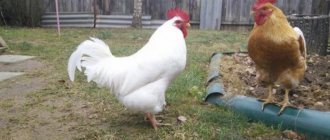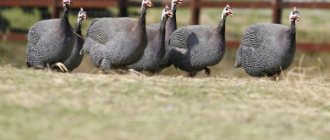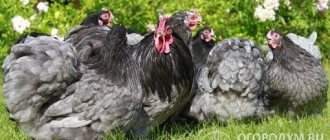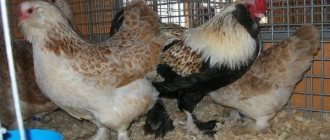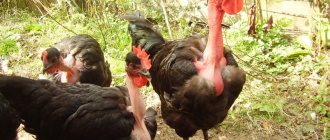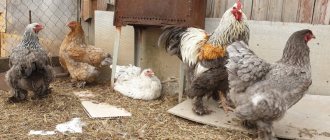Legal aspects of divorce
For many dacha neighbors, chickens in the dacha are nothing more than a spreadable infection, lice, ticks and a way to attract rodents, therefore, often when deciding on the issue of raising poultry on a dacha plot, many private farmers doubt whether the law allows keeping on a dacha plot , for example, 30 or more chickens.
Current legislation provides the opportunity for members of gardening associations to keep animals on the land plots provided to them in such numbers as would ensure compliance with all sanitary standards and would not cause damage to neighbors.
It is prohibited to keep large livestock such as horses, cows and pigs in dachas, but it is better for a dacha poultry house to breed rabbits, goats, lambs and poultry to obtain meat and eggs from them with written consent received from nearby neighbors, having fenced off an area for them and equipped there is an outbuilding on it at a distance of at least 4 m from the boundaries of their plots.
In this case, the building must meet the requirements of fire safety measures and environmental protection rules.
It is worth remembering that livestock farming on a summer cottage cannot have a commercial basis; you can start raising chickens within a gardening partnership solely for personal consumption. Provided that poultry is raised on a small scale exclusively for individual consumption, approval from veterinary supervision for country farming is not required.
Breed selection
In order to make the right choice of breed for breeding in the country, you need to know that all chicken representatives are divided into 3 main lines, depending on their productivity.
- Egg layers are distinguished from the general mass by their egg production indicators, they are small in size, and their sexual maturity is early, as a result of which they begin to lay eggs from the age of 4-5 months. The maximum weight of a chicken is up to 2.2 kg, a rooster is up to 3.0 kg. Egg hens are active throughout the day, require large areas for walking in search of food, and have a good appetite. These breeds include Russian White Chickens, Leghorns, Golden Czechs, Andalusians, White-tailed Reds, and Hamburgs.
- Meat broiler chickens are large in size, rapidly gain weight, and have good taste characteristics of the meat. They can be grown during the spring-summer season, which will be quite enough for weight gain. However, their egg production rates are significantly lower than those of other areas. Among the meat breeds, broilers, Cornishes, Mechelen chickens, Brams, Langshans, and Cochins stand out.
- Meat-egg, or universal, produce average productivity for both meat and eggs. As they grow older, these representatives lose their initial egg production and then go to slaughter. Among the universal ones are the Kyrgyz gray breed, Tsarskoye Selo chickens, Lakenfelders, Sussexes, Chubby chickens, Yurlov birds, Welsumers and the Moscow white breed.
The most popular among country poultry houses are laying hens, which will regularly supply fresh eggs. Among the advantages pointed out by summer residents are their unpretentiousness and stable immunity.
For beginners, it is recommended to start the process of breeding chickens and broilers in the country with unpretentious breeds, which are best kept in quantities of up to 30 pieces.
What do broilers need?
When choosing young meat breeds, you need to pay special attention to their appearance. Healthy chicks can be distinguished by the following characteristics:
- presence of a soft belly;
- active behavior;
- the umbilical cord is not visible;
- the feather cover is shiny and fluffy.
If the young animals are properly maintained and fed with high-quality feed, then by the age of 2 months you can gain up to 3 kg.
The room for chickens should have good ventilation and lighting. To protect young animals from small predators, you need to fence the perimeter of the walking area with a net. But deratization helps against rats and mice, but it is better to do it before introducing birds. This is especially true when using poison that a chicken may accidentally eat.
If a bird has previously been kept in the room, then it is necessary to disinfect it: cover the floors with lime and top with sawdust or other bedding material. Initially, the temperature in the room for young animals is set in the range from +28 to +30 degrees, but gradually it is reduced to +21.
In the first stages of life, broilers are provided with 24-hour lighting and reduced as they grow older. In adult birds, the light remains near the food and water containers. From 30 days of age, chickens can be released for walks in good weather conditions.
Minorcans
Subtleties of purchasing a bird
You can buy the desired breed at a poultry farm or agricultural market, but the most recommended option for purchasing poultry for beginners to raise chickens in the countryside is to buy from breeders. They will be able to give useful advice on raising and keeping poultry, caring for them and feeding procedures. In addition, the risk of purchasing sick or unvaccinated chickens is minimized.
The suspiciously low cost of chickens should be your first concern.
Experts in the field of poultry farming recommend using caution when purchasing heads and it is better to pay attention to the following external aspects:
- the bird must be cheerful and active, not drooping or lethargic,
- chickens should not sit on their feet, remain in a standing position,
- there should be no discharge from the eyes,
- the comb of roosters and hens should be bright red, unless the breed provides for a different color,
- the plumage is smooth and clean.
Pay attention to your breath, which cannot have any odor and should be uniform. It is also worth checking the bird for the presence of parasites in its feathers.
An important point is the age of the bird; for beginners it can be determined in several ways:
- Winter breeding of birds is done extremely rarely due to rising costs of keeping. You should count 5 months (this is the average age of the young) from the date of purchase; if the brood occurs in the winter, then most likely there is deception.
- Before purchasing, it is important to study photos of chicken feet of old chickens and young chickens, and then, when viewing them in person, pay attention to the feet of the proposed individuals.
- The young are distinguished by the brightness of their comb and lobes; these parts of the body of a young bird are warm to the touch.
The greatest difficulties arise for beginners when purchasing chickens, which are chosen taking into account certain features:
- chickens must have a reaction to a voice or noise (knocking),
- at the sight of a treat, the chickens’ reaction is quite fast and active,
- The feather cover of chickens has a smooth and even structure.
Do you want to adopt chickens for the summer? 10 facts no one will tell you about
We have all heard the slogans more than once that chickens are unpretentious, eat what you give, live on a couple of squares, and most importantly, easily and without any fuss, provide the family of summer residents with fresh and tasty eggs. And the Internet is full of offers to adopt chickens (whether pullets, laying hens, or chicks) all year round, especially in the spring.
This year we decided to become the happy owners of laying hens. This is understandable - self-isolation, canceled trips, a child stuck at home all the time - all this encourages you to discover new horizons for yourself. Alas, not everything turned out to be as rosy as on the pages of sites offering chickens for sale and even for rent. I will share the knowledge that cost me a lot.
It won't pay off
I’ll say right away: buying eggs from a farmer for the whole family all summer will be cheaper than buying chickens, building them housing, providing them with food, treating them and protecting them from pests, etc. Therefore, seasonal poultry farming can only be considered as a hobby, and not the cheapest one.
Even if you have a barn in which you are going to fence off a corner for the birds, buying everything you need (and the chickens themselves) will still cost a pretty penny.
- How to build a summer chicken coop with your own hands in a few days
Drawings, photos, calculations of materials and a detailed description of the stages of building a chicken coop for those who decide to build it themselves.
The chickens are dying
I know this sounds terrible, and now you will all start writing that when you were a child in your village, chickens ran around on their own, laid eggs the size of a fist and never got sick. And of course, if you have the opportunity to take village chickens from under the hen, their immunity will be strong. Do you know why? Because all weak and non-viable individuals passed (or rather did not pass) natural selection at the egg or chick stage.
But most of the offerings on the market now are “incubator”, growing in a brooder and then in a cage and having no idea what grass, worms, birds of prey and other “joys of life” are. The immunity of these creatures, even if the breeder was not greedy with vaccinations, is quite different from the immunity of those village chickens from childhood that you remember. They can die from heat, cold, stuffiness, improper feed, nails caught in the enclosure, or even simply pecking on their own droppings. Moreover, if you can control the first factors, then there is nothing you can do about the last one, except that you stand over them 24/7 and watch.
By the way, the village chickens also died, but they immediately went into the dog’s soup, and you didn’t notice it.
- Country house: how to recognize that a chicken is sick - first aid and prevention
We talk about the most common problems that chicken owners may encounter.
Breeders will try to deceive you
Oh, how endless the world of poultry farming tricks is and how defenseless are summer residents who decide to take their first chickens. Here we have the sale of moulted two-year-olds as four-month-olds “already almost laying hens,” and the imposition of outright culling, and the lack of vaccinations. One of the sellers even tried to sell us a young rooster, claiming that it was just a very bright chicken.
We are all aware of stories when at the poultry market, instead of an expensive puppy, a mongrel puppy was sold, but for some reason we believe that this will not happen with chickens. So, it won’t be like that.
Chickens from a poultry farm are more reliable than those from an unknown private owner
If there is a state-owned poultry farm near you that sells young birds, play it safe and buy them there. All vaccinations have been done there, the birds have definitely undergone regular veterinary checks, and they will give adequate advice on maintenance and feeding. And you will be sure that you are dealing with professionals, and not with someone who first took birds a few months before you and decided to recoup the investment.
The more exotic the breed, the more capricious it is
Should I take a Belarusian white or a Czech dominant? The choice is obvious, isn't it? What does that white one have to offer - it’s not beautiful, doesn’t have a record egg production, and you can’t brag about it to your neighbors. Or exotic breeds with bright plumage, colored eggs, furry legs and black combs!
Yes, exotics are good. But it is strictly not recommended to take them as the first birds. First, practice on stable breeds adapted to our climate, food, and diseases. And only then (if you don’t howl when cleaning the chicken coop in the first hot summer) add bright colors to the flock.
- What kind of chickens lay colored eggs?
A poultry farmer from the Moscow region shares his experience of raising unusual breeds of chickens.
“All summer with eggs” won’t work
Most of the modern breeds on offer begin laying eggs at 5 months. At the same time, either chickens, or adult laying hens that have already “worked” for a year, or three-month-old chickens are most often sold.
There is no point in taking chickens - they will not have time to grow up to egg-laying age during the summer season. Adult, experienced laying hens can decide at any time (including right after moving) that they have completed their mission and are not going to lay any more eggs. And finally, hens at 3-4 months of age, which are the most expensive, will also not start laying eggs right away. Taken for the May holidays, they will give you the first egg around June, and then gradually begin to swing. At first, a chicken needs 3-4 days to produce an egg, then things will go faster. By the end of the season, they will already reach the promised egg production, but here another problem awaits you.
Food can be counterfeit
Don’t try to save money on feed by purchasing grain from someone you know. Yes, wheat and corn from men with the appearance (and smell) of a real villager will be cheaper than in the store. But there is a possibility that this grain was prepared for sowing, and not for feed. During storage, it is treated against diseases and pests, and the storage facilities themselves are treated with strong drugs.
Such savings will smoothly (and sometimes not very smoothly) again lead you to point 2.
Domestic eggs cannot be produced on feed alone
There are many complete feeds on the market. It would seem that choose a good one, pour water into the drinking bowl and don’t think about the chickens for several days. Yes, this is also possible, and there are automatic feeders and drinkers that allow you to provide birds for a week in advance and go for eggs on weekends.
But the eggs obtained in this way will be no different from those lying on the shelf in the store. This means that your hobby will simply lose its meaning. Therefore, if you want the same thing with a bright yolk, prepare grain mixtures, provide walking, fresh vegetables and herbs, the opportunity to rummage in the ground and get a worm, and also do not forget about shells or shell rock, fish meal, meal, yeast and many other chicken delicacies .
- What to feed chickens to help them lay eggs better
Have you decided to have laying hens? Find out what to feed them in advance to ensure you have eggs all year round.
You will have to roost the chickens for the first week.
It would be funny, but it's a fact. Chickens raised in cages do not know what a roost is and do not know how to use it. Therefore, if it is important to you that they do not sleep on the cold floor or in nests and, accordingly, do not shit in them, you will have to accustom them to roost yourself.
It's not difficult: just arrive at dusk and place the chickens in their places. Children even like this “show”.
By the way, many modern laying hens that grew up in cages are also not aware of the purpose of the nests, so they lay right on the floor. If such a problem arises, place a painted wooden egg or a ping-pong ball in the nests - over time, the chickens will understand what you want from them.
Where to put chickens in winter
If you had a cunning plan - to receive eggs from chickens in the summer and send the laying hens to soup in the fall, I want to disappoint you right away - it won’t work. And the point is not only that a laying hen, even in its best years, does not look like the broiler we are used to from a poultry farm. It’s just that after everything you go through with them in the summer, you won’t be able to cut off their heads.
And the search will begin for a village resident with a year-round chicken coop and attempts to place his birds there for the winter. By the way, such services exist, but you will have to pay extra for food and maintenance.
Am I discouraging you from taking chickens to your dacha? Not at all. I just want you to not have to face the difficulties that I went through, and that you approach the issue of raising poultry without “rose-colored glasses.”
Poultry house space
A comfortable stay for birds in a summer cottage depends on the correct choice of location for an outbuilding and an equipped enclosure.
In addition to the fact that the location for the chicken coop must be chosen at a distance of at least 4 m from the boundaries of neighboring land plots, it must be sufficiently illuminated throughout the day, but not be exposed to direct sunlight. The dryness of the soil layer is of no small importance, therefore it is not recommended to build an outbuilding for breeding and keeping chickens in a country house in a lowland or swamp. Sites exposed to strong winds and under trees are not suitable for placing a poultry house.
The most favorable place will be one that is inclined: rainwater will not accumulate, but will begin to flow away, leaving the soil layer of the paddock to dry out.
When planning the size of the site, you should not forget about the need to arrange a place for birds to walk in such a size that the enclosure requires 1 square meter for 1 laying hen or cockerel. m area.
At what age should young chickens be taken?
Laying hens are usually taken at four months of age to avoid problems with rearing and to know for sure that this is a chicken. Chickens are more interesting when choosing meat breeds; in this case, it does not matter who will eventually grow out of them, and it is easier to influence growth and weight when feeding from a day old.
At first, all laying hens produce small eggs, so you should focus on the numbers after a year of keeping them. A rooster is bought only for breeding chickens, since chickens lay a little worse with it. Every year you need to add a couple of chickens, then the process of fresh eggs appearing on your table will not stop. New laying hens should be kept in a separate room for a week so as not to accidentally infect the poultry with something.
Construction of a poultry house
The chicken coop should be built in such a way that 1 to 2 dozen chickens will feel comfortable in an area measuring 2*3 meters. At the same time, the quality and fundamental nature of the structure depends on the period in which the selected rock will be kept.
Spring-summer breeding
Keeping chickens starting in spring and summer assumes that the poultry house does not require insulation and a simple shed with a roof or a canopy that can protect the birds in case of bad weather and a pen is suitable as a room for the chickens to live. No additional lighting is required in the summer.
Year-round chicken breeding
Breeding and maintaining a population of chickens on a summer cottage throughout the entire calendar year will require the construction of an insulated structure in order to preserve the population during the onset of winter cold. It is necessary to provide heating that would keep the temperature from 11 to 22°C. If there is enough natural light in the summer, then in the winter they often resort to artificial lighting to maintain daylight hours up to 18-20 hours.
Interior arrangement
Among the recommendations given by professional poultry houses, the dimensional parameters of the internal arrangement are important:
- the height of the chicken coop should be within 2.2 m,
- perches are made at a height of 1.1 m in length based on 1 hen with 15-20 cm of space,
- the window is also placed at a distance of 1.1 m from the floor, it is better if its dimensions are 0.5 * 0.5 m with a chicken coop area of 1.5 * 2.0 meters; as the area increases, the number of windows increases,
- the floor is lined with sand mixed with shavings,
- For the free exit of chickens from the chicken coop, a hole half a meter wide is made.
Equipping with nests is of no small importance in interior design, especially if the owner intends to breed and raise an egg breed. As a nest for hatching chickens and laying eggs, you can choose a box or make your own structure with a width of 0.5 m and a depth of 0.6 m, which is covered with straw or hay. You can watch the video to see how it looks correctly. One nest is usually enough for 3 laying hens.
You can watch a video on how to set up a chicken coop.
Process
Raising chickens at home is not difficult if there are hens among the chickens. The breeding process is impossible without a rooster. A healthy bird with high egg production is chosen as a brood hen. Eggs must be carefully selected; they must be of the correct shape, not very large or small, without deformation, cracks or dirt.
REFERENCE! The number of eggs that should be placed under a chicken depends on the time of year and the size of the bird itself, usually 10 - 20 eggs. Chicks begin to hatch from the twentieth day. As the chicks begin to hatch, the remaining shells are removed from under the chicken.
When the time has come and all the chicks have hatched, the nest is thoroughly cleaned, filled with fresh sawdust or straw, after which the hen and chicks are carefully placed in place.
Feeding and care rules
Often, beginners are faced with a lack of knowledge in the field of proper feeding of birds, therefore beginners when raising chickens in the country are recommended to purchase ready-made mixtures selected according to the age of the laying hen.
Among the basic rules for feeding poultry is two meals a day, subject to the availability of fresh greens. The bird's diet should include:
- grain of 2 types - 45 g each in spring and autumn, 40 g in summer and 50 in winter,
- crushed grain of 2-3 types - 55 g each in spring and autumn, 60 g in summer and 50 g in winter,
- meal and cake - 12 g throughout the year,
- bran - 10 g throughout the year,
- boiled potatoes - 20 g each in summer and autumn, 50 g each in spring and winter,
- yeast - 3 g throughout the year,
- carrots or silage - 40 g each in spring and winter, in spring - 20 g,
- grass or greens - 10 g each in spring and winter, 50 g in summer and 30 g in autumn,
- meal (meat and bone, fish) - 5 g throughout the year,
- return - 20 g each in spring, autumn and winter, 30 g in summer,
- shell rock and chalk - 4 g each throughout the year,
- salt - 0.5 g throughout the year.
Cereals are considered the most beneficial. The birds themselves prefer mash - a mixture of vegetables, feed and herbs. The supply of necessary vitamins is ensured by fresh grass and greens.
On average, one individual eats about 185 g of feed per day. Depending on the breed, this indicator can be either lower (in egg birds) or higher (in broilers).
Caring for chickens at a summer cottage means vaccinating, regularly inspecting birds, identifying sick individuals and isolating them from the main flock. Caring for chickens also includes timely cleaning and disinfection. During the period of keeping hens, you need to monitor the availability of drinking water.
How to feed laying hens correctly
Fresh grass is the optimal source of vitamins and microelements for chickens. Therefore, install the enclosure in such a way as to provide the laying hens with a sufficient amount of weeds. A portable enclosure can handle this very well. But in this case, you will need a lot of space, which is not very convenient given the small area of the plot and the presence of beds on it. But this is not a problem: constantly weeding the beds from weeds, pour the grass into the poultry pen. It would be enough.
Feed specifically designed for laying hens will help increase potential. You will not need additional feeding because this food is perfectly balanced and nutritious.
Buy cereals for your laying hens: wheat, oats, barley. These crops can be used either individually or in the form of mixtures. In some cases, vitamin and mineral supplements will be needed, but usually the grain is sufficient for proper growth and good wear.
Provide birds with containers for food and drink.
In any case, you need to constantly monitor the condition of the chickens and their fatness. Low weight and excessive obesity can equally lead to decreased egg production and the development of diseases. The optimal amount of feed for each laying hen is no more than 150 g per day. And don't forget to add fresh water every day.
Small chickens need special food. It should include:
- ground corn;
- semolina;
- millet;
- finely chopped boiled chicken eggs;
- ground carrots;
- finely chopped greens: cabbage, lettuce, dandelion, etc.
For chickens aged 1 month or more, the food will be grain, mixed feed, potato peelings and other food waste with the addition of crushed chalk - a source of essential calcium.
